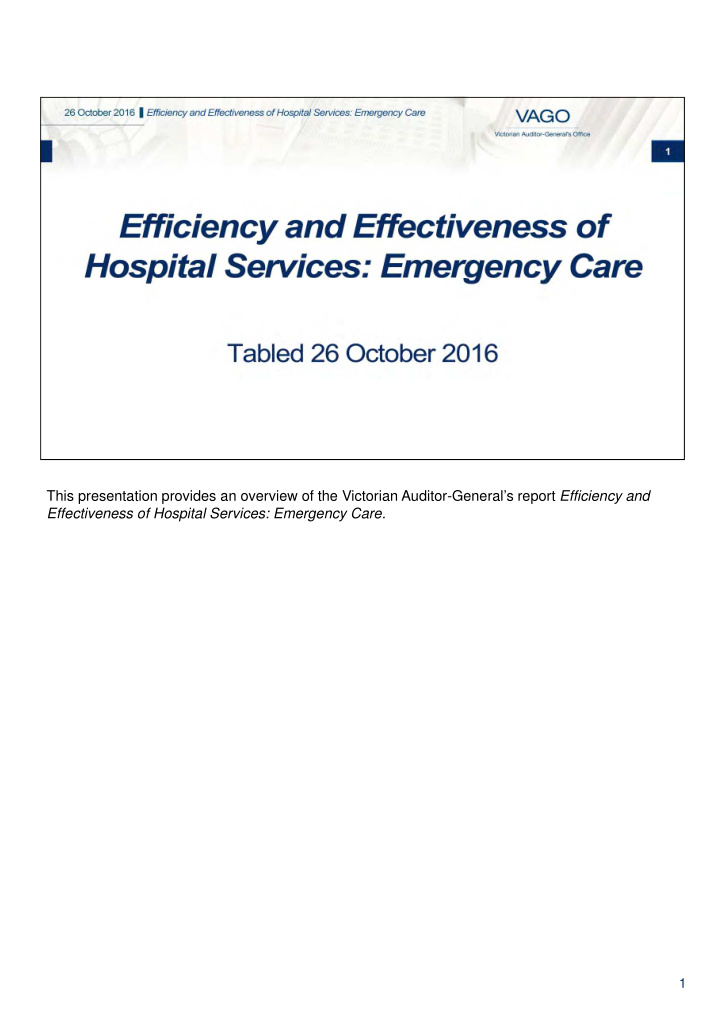



This presentation provides an overview of the Victorian Auditor-General’s report Efficiency and Effectiveness of Hospital Services: Emergency Care. 1
Growing demand for hospital services has been a persistent problem in Victoria and nationally for more than a decade. The effects of higher demand are most visible in the pressure point of public hospitals: emergency departments (EDs). In 2015–16, the Department of Health & Human Services (the department) spent around $565 million on emergency care, which is almost 5 per cent of the budget for acute services. More than 1.5 million people attended a public ED in Victoria, an increase of 8.2 per cent from 2010–11. In comparison, Victoria’s population increased by 6.1 per cent between 2010 and 2014. 2
In 2015, the department set a target of 81 per cent of ED patients to be discharged or admitted to an in-patient ward within four hours. When EDs run well, patients can access care that is appropriate, meets their needs and involves no unnecessary waiting. Shorter visits to the ED are better for patients and are a more efficient use of public resources 3
In this audit, we looked at whether public hospitals are managing EDs efficiently and effectively, and we assessed how the department supports and oversees emergency care. Our report highlights gaps and weaknesses in emergency care, which can help the department to set the right goals and incentives to achieve more consistent hospital performance and more targeted monitoring and oversight for areas that most need support. 4
Public hospitals have reduced the average length of stay for ED patients during the past four years, despite a rise in the volume and complexity of patients presenting to EDs. Although hospitals have improved their efficiency in treating and discharging less urgent patients, improvements have been slower for urgent patients. Sometimes the length of stay for patients who need to be admitted for further treatment is protracted because there are no in-patient beds available in wards. Few hospitals are meeting the target of 81 per cent of presentations discharged or admitted within four hours. 5
A common theme in hospitals that maintained or improved performance was strong leadership that engaged the whole hospital in being accountable for managing demand in the ED. Strong direction and a united approach helped patients to access in-patient wards faster. Early decision-making by senior staff, good patient discharge planning, and a commitment to removing barriers between the ED and in-patient wards help to improve the flow of patients through the hospital. 6
Effective use of short-stay units (SSU) was another common theme in strong-performing hospitals. SSUs are medical observation units, designed for ED patients who are likely to be discharged within 24 hours. Admissions to SSUs correlate with better performance against the four-hour target for admitted patients. In 2014–15, up to 35 per cent of all ED patients and up to 80 per cent of admitted ED patients were admitted to an SSU. However, there is a risk that short-stay admissions can be used to mask long waiting times in ED. The department needs to better understand the extent and causes of variation in use of SSUs to determine whether it needs to update its criteria. The department advised that it plans to develop quality and timeliness measures for SSUs. 7
The department has not sufficiently monitored ED performance and has not held hospitals to account for underperformance. One hospital that was being monitored for poor performance over two years was not required to submit any strategies for improvement. 8
The department relies on performance data that is inaccurate due to inconsistent recording of patient re-presentation to ED. Its performance measures for effectiveness lack quality and safety indicators, and its approach to managing poor hospital performance has been, until recently, informal and insufficiently documented. 9
The quality of departmental monitoring has not reflected the serious risk of adverse patient outcomes that could occur through poor ED performance. The department recognises this and is taking steps to improve its performance framework. 10
We made three recommendations directed to health services and six recommendations directed to the department. We recommended that health services review processes for urgent patients and commit to improve patient flow. We recommended that the department update its short-stay guidance, develop additional measures of effectiveness, and strengthen monitoring of poor performing hospitals We made a number of recommendations to improve the emergency dataset- to make data is entered consistently and that data audit findings are resolved and implemented All recommendations have been accepted. 11
For further information, please see the full report of this audit on our website, www.audit.vic.gov.au. 12
Recommend
More recommend